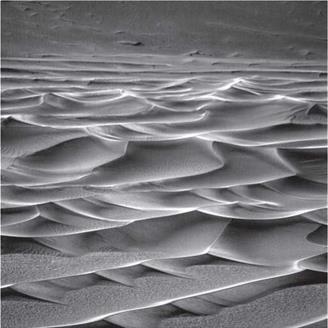Outfitting the Field Geologists
If you were a field geologist, your most valuable asset would be your eyes. Geologists are trained to recognize rocks and minerals and crystals, using archetypal images in textbooks and samples in the lab. But hand-picked samples, viewed in isolation, can never prepare a geologist for the complexity and apparent chaos of a real landscape (figure 3.1). Rocks are sometimes layered and sometimes jumbled, their color and texture can change according to lighting conditions and perspective, and each rock’s story only makes sense in the light of the surrounding terrain. Experienced geologists must take all this in through their eyes. With little atmosphere on Mars to carry sound or smell, sight is the critical sense.
The rovers’ eyes sit at the top of a mast, roughly five feet off the ground. Twin CCD cameras are used to form stereo images. The cameras can rotate 360 degrees to make a complete panorama, and pivot 18 degrees to scan the landscape or the sky. With 16 megapixels, they are similar to high-end digital cameras you could buy, and each one weighs nine ounces and could fit in the palm of your hand. But unlike a commercial device, the rover cameras have a large set of color filters designed to help diagnose the composition of rocks and minerals, and a set of solar filters for looking at the Sun. Like some new cars, the rovers also have “hazard avoidance” cameras, one pair on the front and one pair on the back,
|
Figure 3.1. A view down into Victoria Crater by the Opportunity rover as part of its seven-year exploration of the Martian surface. The dunes are similar to those seen on Earth, sculpted by wind in the thin atmosphere and shifting from season to season. In 2011, Opportunity reached Endeavor Crater, some 14 miles across (NASA/Jet Propulsion Laboratory). |
each looking ten feet out to help avoid any unexpected collisions or obstacles.
Spirit and Opportunity may be one-armed geologists, but those arms are highly capable, with an elbow, a wrist, and four modes of motion. In the mechanical “fist” of each arm is a pint-sized imager that acts like the hand-held magnifying lens carried by many geologists. Just as no geologists would do any fieldwork without their trusty hammer, so each rover arm is equipped with a Rock Abrasion Tool (or RAT). The RAT is a muscular, diamond-studded grinder; in two hours it can carve out a hole 2 inches across and 1/5 inch deep into even the hardest volcanic rock.20 Rock interiors can be quite different from the exteriors, which have been subject to weathering and radiation and may be coated in dust. After the RAT has finished its work, the microscopic imager can peer into the hole and two other science instruments can be pivoted into position to study the rock. One, called a Mossbauer spectrometer, is specifically designed to study iron-bearing minerals with high precision. It takes about twelve hours to do a single measurement. The other is called an Alpha Particle X-ray Spectrometer. It has an onboard source of alpha particles—high-energy helium nuclei—and it can bounce either those or X-rays off the rock sample. The results give the elemental composition, which is important in deciding how different chemicals came together to form minerals within the rock. These measurements take about ten hours per sample.
The rovers’ suite of sophisticated instruments is completed by the Miniature Thermal Emission Spectrometer. All objects emit heat, and the spectrum of their heat can be used to deduce their composition. This instrument is particularly designed to look for minerals that can only be made in the presence of or by the action of water, such as carbonates and clays. It weighs five pounds and it sits in the rover’s body, but it has a periscope so it can look out alongside the rover’s eyes, and it can also gaze upward to gather measurements on the temperature, water vapor content, and presence of dust in the atmosphere.
Finally, like many good science fair projects, the Mars Exploration Rovers make use of magnets.
Magnetic dust grains are freeze-dried remnants of the planet’s wetter past, where some types of molecules align with the Martian magnetic field when they are in solution, and then preserve that orientation when the mineral solidifies. Magnetic minerals give additional clues to the geological history. One pair of magnets sits at the end of the robotic arms, where it can gather magnetized particles ground out by the RAT. Another pair of magnets is at the front of the rover, tilted such that non-magnetic particles will fall off. Two of the spectrometers then analyze any particles that stick there.











